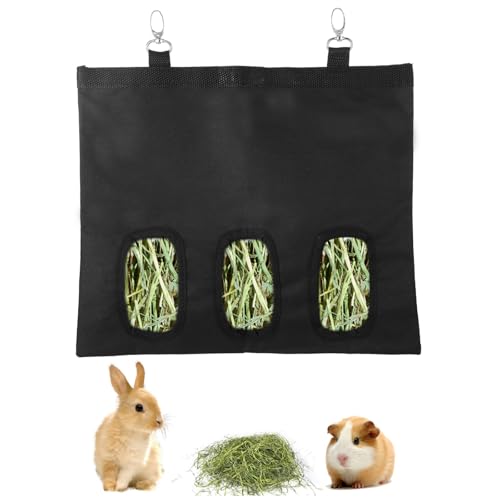SAFE PLANTS FOR RABBITS
Updated October 25, 2021
Disclaimer: This list is provided for informational purposes and is a guideline only. To the best of my knowledge, all the plants listed here are safe for rabbits when fed in moderation as directed; however, neither I nor RabbitTalk will be responsible in any way for any ill effects that may occur from using these plants.
Plants that I have NOT routinely fed to my own rabbits are marked with an asterisk. This indicates only that I did not have access to them and therefore have no first-hand experience with them.
Please always use botanical names for identification purposes; common names vary from place to place and are not a reliable tool for identifying plants.
This list is a work in progress will be updated from time to time as needed. Please post suggestions for additions and questions about the safety of other plants in separate threads in this forum.
~ MaggieJ
_____________________________________________________________________________
Common Name Botanical Name Parts of Plants to Feed Comments
alfalfa Medicago sativa Above ground parts
apple Malus domestica Leaves, branches, fruit Seeds considered toxic.
basil Ocimum basilicum Above ground parts
blackberry Rubus spp. Above ground parts Useful against diarrhea
borage Borago officinalis Above ground parts
carrot Daucus carota sativus All parts, except seeds Seeds contraceptive
cat-tail Typha latifolia All parts
chickweed Stellaria media Above ground parts
chicory, wild Cichorium intybus All parts
cilantro* Coriandrum sativum Leaves, stems
clover, red Trifolium pratense Above ground parts
clover, white Trifolium repens Above ground parts
comfrey* Symphytum officinale Leaves Best dried.
dandelion Taraxacum officinale All parts
grape Vitus spp. Leaves, vines
hackberry* Celtis occidentalis Leaves, twigs
jewelweed Impatiens capensis Leaves, stems
kudzu* Pueraria lobata Above ground parts
lambs-quarters Chenopodium album Above ground parts
lemon balm Melissa officinalis Above ground parts
mallow Malva spp. All parts
maple, silver Acer saccharinum Leaves and branches
maple, sugar Acer saccharum Leaves and branches
mesquite* Prosopis juliflora Leaves and twigs
mint Mentha spp. Above ground parts Not to pregnant/nursing does.
mulberry, white* Morus alba Leaves, twigs, branches
nettle, stinging Urtica dioica Above ground parts. Caution: Must be dried first.
parsley Petroselinum crispum Above ground parts.
pear Pyrus communis Leaves, branches, fruit. Seeds may be toxic.
pigweed Amaranthus albus Leaves, stems.
plantain Plantago spp. Above ground parts. Useful against diarrhea
poplar Populus spp. Leaves, twigs, branches Inner bark relieves pain
pumpkin, squash Curcurbita spp. Above ground parts Seeds are a wormer
purslane Portulaca oleracea Above ground parts
Queen Anne’s Lace Daucus carota All parts, except seeds. Seeds contraceptive
radish Raphanus sativus All parts.
raspberry Rubus idaeus Above ground parts. Useful against diarrhea
red osier dogwood* Cornus sericea Above ground parts.
redroot pigweed Amaranthus retroflexus Above ground parts
rose Rosa spp. Above ground parts
sage, garden Salvia officinalis Above ground parts Not to pregnant/nursing does
sow thistle, annual Sonchus oleraceus Above ground parts
sow thistle, perennial Sonchus arvensis Above ground parts
sow thistle, spiny Sonchus asper Above ground parts
strawberry Fragaria spp. Above ground parts
sunflower Helianthus annuus Above ground parts
sweet potato Ipomoea batatas Tubers, vines and leaves Rich, potentially fattening
sycamore, American Platanus occidentalis Leaves, twigs, bark
willow Salix spp. Leaves and branches. Inner bark relieves pain
yarrow Achillea millefolium Leaves, stems. Not to pregnant/nursing does
Updated October 25, 2021
Disclaimer: This list is provided for informational purposes and is a guideline only. To the best of my knowledge, all the plants listed here are safe for rabbits when fed in moderation as directed; however, neither I nor RabbitTalk will be responsible in any way for any ill effects that may occur from using these plants.
Plants that I have NOT routinely fed to my own rabbits are marked with an asterisk. This indicates only that I did not have access to them and therefore have no first-hand experience with them.
Please always use botanical names for identification purposes; common names vary from place to place and are not a reliable tool for identifying plants.
This list is a work in progress will be updated from time to time as needed. Please post suggestions for additions and questions about the safety of other plants in separate threads in this forum.
~ MaggieJ
_____________________________________________________________________________
Common Name Botanical Name Parts of Plants to Feed Comments
alfalfa Medicago sativa Above ground parts
apple Malus domestica Leaves, branches, fruit Seeds considered toxic.
basil Ocimum basilicum Above ground parts
blackberry Rubus spp. Above ground parts Useful against diarrhea
borage Borago officinalis Above ground parts
carrot Daucus carota sativus All parts, except seeds Seeds contraceptive
cat-tail Typha latifolia All parts
chickweed Stellaria media Above ground parts
chicory, wild Cichorium intybus All parts
cilantro* Coriandrum sativum Leaves, stems
clover, red Trifolium pratense Above ground parts
clover, white Trifolium repens Above ground parts
comfrey* Symphytum officinale Leaves Best dried.
dandelion Taraxacum officinale All parts
grape Vitus spp. Leaves, vines
hackberry* Celtis occidentalis Leaves, twigs
jewelweed Impatiens capensis Leaves, stems
kudzu* Pueraria lobata Above ground parts
lambs-quarters Chenopodium album Above ground parts
lemon balm Melissa officinalis Above ground parts
mallow Malva spp. All parts
maple, silver Acer saccharinum Leaves and branches
maple, sugar Acer saccharum Leaves and branches
mesquite* Prosopis juliflora Leaves and twigs
mint Mentha spp. Above ground parts Not to pregnant/nursing does.
mulberry, white* Morus alba Leaves, twigs, branches
nettle, stinging Urtica dioica Above ground parts. Caution: Must be dried first.
parsley Petroselinum crispum Above ground parts.
pear Pyrus communis Leaves, branches, fruit. Seeds may be toxic.
pigweed Amaranthus albus Leaves, stems.
plantain Plantago spp. Above ground parts. Useful against diarrhea
poplar Populus spp. Leaves, twigs, branches Inner bark relieves pain
pumpkin, squash Curcurbita spp. Above ground parts Seeds are a wormer
purslane Portulaca oleracea Above ground parts
Queen Anne’s Lace Daucus carota All parts, except seeds. Seeds contraceptive
radish Raphanus sativus All parts.
raspberry Rubus idaeus Above ground parts. Useful against diarrhea
red osier dogwood* Cornus sericea Above ground parts.
redroot pigweed Amaranthus retroflexus Above ground parts
rose Rosa spp. Above ground parts
sage, garden Salvia officinalis Above ground parts Not to pregnant/nursing does
sow thistle, annual Sonchus oleraceus Above ground parts
sow thistle, perennial Sonchus arvensis Above ground parts
sow thistle, spiny Sonchus asper Above ground parts
strawberry Fragaria spp. Above ground parts
sunflower Helianthus annuus Above ground parts
sweet potato Ipomoea batatas Tubers, vines and leaves Rich, potentially fattening
sycamore, American Platanus occidentalis Leaves, twigs, bark
willow Salix spp. Leaves and branches. Inner bark relieves pain
yarrow Achillea millefolium Leaves, stems. Not to pregnant/nursing does
Last edited:
































